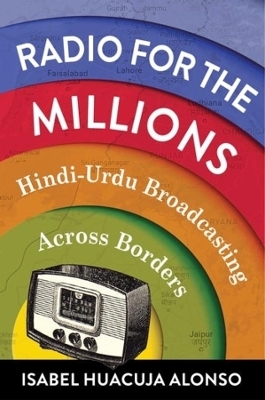
Radio for the Millions
Hindi-Urdu Broadcasting Across Borders
Seiten
2023
Columbia University Press (Verlag)
978-0-231-20661-7 (ISBN)
Columbia University Press (Verlag)
978-0-231-20661-7 (ISBN)
Radio for the Millions examines Hindi-Urdu radio during the height of its popularity from the 1930s to the 1980s, showing how it created transnational communities of listeners. Isabel Huacuja Alonso argues that despite British, Indian, and Pakistani politicians’ efforts to usurp the medium for state purposes, radio largely escaped their grasp.
Winner, 2024 Columbia University Press Distinguished Book Award
Co-winner, 2023 AIPS Book Prize, American Institute of Pakistan Studies
Finalist, 2023 Richard Wall Memorial Award, Theatre Library Association
From news about World War II to the broadcasting of music from popular movies, radio played a crucial role in an increasingly divided South Asia for more than half a century. Radio for the Millions examines the history of Hindi-Urdu radio during the height of its popularity from the 1930s to the 1980s, showing how it created transnational communities of listeners.
Isabel Huacuja Alonso argues that despite British, Indian, and Pakistani politicians’ efforts to usurp the medium for state purposes, radio largely escaped their grasp. She demonstrates that the medium enabled listeners and broadcasters to resist the cultural, linguistic, and political agendas of the British colonial administration and the subsequent independent Indian and Pakistani governments. Rather than being merely a tool of nation building in South Asia, radio created affective links that defied state agendas, policies, and borders. It forged an enduring transnational soundscape, even after the 1947 Partition had made a united India a political impossibility.
Huacuja Alonso traces how people engaged with radio across news, music, and drama broadcasts, arguing for a more expansive definition of what it means to listen. She develops the concept of “radio resonance” to understand how radio relied on circuits of oral communication such as rumor and gossip and to account for the affective bonds this “talk” created. By analyzing Hindi film-song radio programs, she demonstrates how radio spurred new ways of listening to cinema. Drawing on a rich collection of sources, including newly recovered recordings, listeners’ letters to radio stations, original interviews with broadcasters, and archival documents from across three continents, Radio for the Millions rethinks assumptions about how the medium connects with audiences.
Winner, 2024 Columbia University Press Distinguished Book Award
Co-winner, 2023 AIPS Book Prize, American Institute of Pakistan Studies
Finalist, 2023 Richard Wall Memorial Award, Theatre Library Association
From news about World War II to the broadcasting of music from popular movies, radio played a crucial role in an increasingly divided South Asia for more than half a century. Radio for the Millions examines the history of Hindi-Urdu radio during the height of its popularity from the 1930s to the 1980s, showing how it created transnational communities of listeners.
Isabel Huacuja Alonso argues that despite British, Indian, and Pakistani politicians’ efforts to usurp the medium for state purposes, radio largely escaped their grasp. She demonstrates that the medium enabled listeners and broadcasters to resist the cultural, linguistic, and political agendas of the British colonial administration and the subsequent independent Indian and Pakistani governments. Rather than being merely a tool of nation building in South Asia, radio created affective links that defied state agendas, policies, and borders. It forged an enduring transnational soundscape, even after the 1947 Partition had made a united India a political impossibility.
Huacuja Alonso traces how people engaged with radio across news, music, and drama broadcasts, arguing for a more expansive definition of what it means to listen. She develops the concept of “radio resonance” to understand how radio relied on circuits of oral communication such as rumor and gossip and to account for the affective bonds this “talk” created. By analyzing Hindi film-song radio programs, she demonstrates how radio spurred new ways of listening to cinema. Drawing on a rich collection of sources, including newly recovered recordings, listeners’ letters to radio stations, original interviews with broadcasters, and archival documents from across three continents, Radio for the Millions rethinks assumptions about how the medium connects with audiences.
Isabel Huacuja Alonso is an assistant professor in the Department of Middle Eastern, South Asian, and African Studies at Columbia University.
List of Figures
Note on Transliteration
Introduction: Tuning In to a Radio History
Part I: Radio News And World War II
1. News on the AIR
2. Netaji’s “Quisling Radio”
Part II: Music And Postindependence Radio
3. The “Sound Standards” of a New India
4. Radio Ceylon, King of the Airwaves
Part III: Dramatic Radio and the 1965 Indo-Pakistan War
5. Radio Pakistan’s Seventeen Days of Drama
6. The AIR Urdu Service’s Letters of Longing
Conclusion: Call to Me. Where Are You?
Acknowledgments
Notes
Bibliography
Index
| Erscheinungsdatum | 10.10.2022 |
|---|---|
| Verlagsort | New York |
| Sprache | englisch |
| Maße | 156 x 235 mm |
| Themenwelt | Kunst / Musik / Theater ► Theater / Ballett |
| Sachbuch/Ratgeber ► Sport ► Tanzen / Tanzsport | |
| ISBN-10 | 0-231-20661-5 / 0231206615 |
| ISBN-13 | 978-0-231-20661-7 / 9780231206617 |
| Zustand | Neuware |
| Haben Sie eine Frage zum Produkt? |
Mehr entdecken
aus dem Bereich
aus dem Bereich


